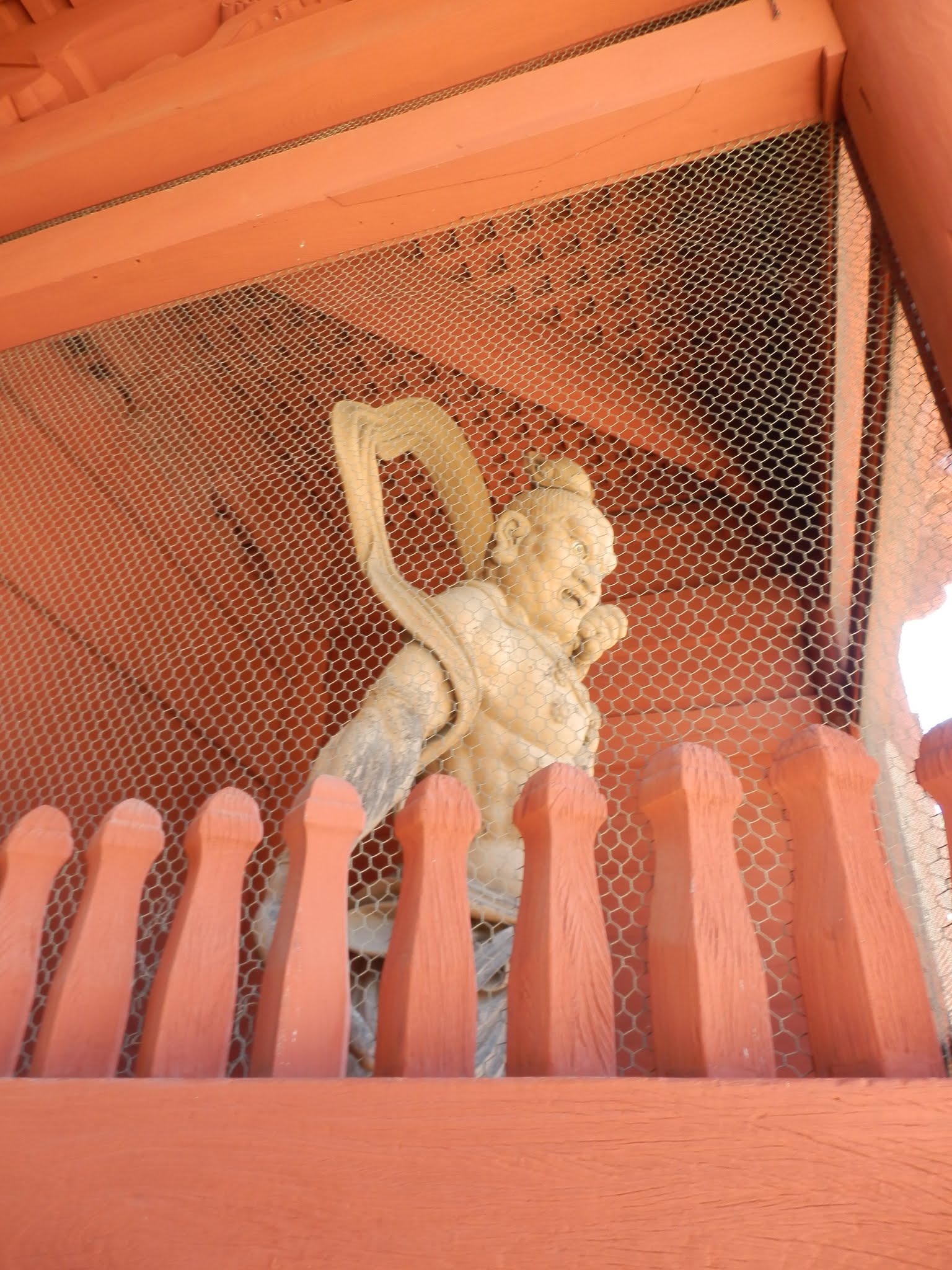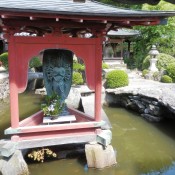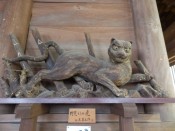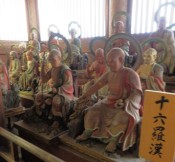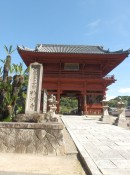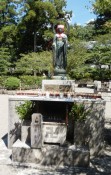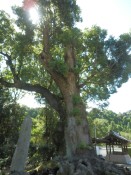Saigoku Kannon Pilgrimage: Kokawadera 粉河寺
Continuing on the Wakayama-ken portion of the pilgrim trail, we arrive next at the temple numbered 3 of 33: Kokawadera.
This temple is not too far from our previous temple, Kimiidera, and the two make a good combination trip. The image enshrined in Kokawadera is a truly secret image and never put on display, called Yakuyoke Kannon (厄除観音), a senju (thousand-armed) Kannon dedicated to protecting all beings from disaster. The original image was once destroyed during the Kii offensive, and only the head survived, giving it a stronger association with disaster prevention.  Although the image is never shown, it is believed that Donan Gyoja was a living manifestation of Kannon, and his image is enshrined in the Donan-do, open to the public every year on December 18th. As a manifestation, the images are said to be the same.
Otherwise, the main attractions of Kokawadera are mostly artistic in nature.
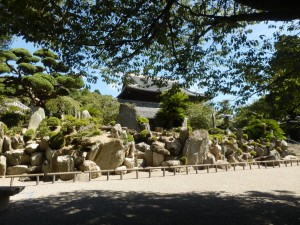 Perhaps the most famous is the rock garden in front of the Hondo. Created during the Momoyama era, it’s an important example of the karesansui (dry arrangement) style of garden sometimes seen at Zen temples. Most Zen gardens, however, are simple in comparison to the busy and contrived nature of Kokawadera’s Teien Garden; using many rock formations and stylized shrubbery in close proximity, the garden at Kokawadera gives a rather baroque impression. The rocks come from all over Japan, and the formations are designed to tell stories from the “Eight Scenic Places of Omiâ€â€”places of noted scenic beauty around Lake Biwa and other famous gardens like the Katsura palace in Kyoto. The cycad plants are also striking, and are said to be the original ones brought in from Okinawa some 400 years ago.
Perhaps the most famous is the rock garden in front of the Hondo. Created during the Momoyama era, it’s an important example of the karesansui (dry arrangement) style of garden sometimes seen at Zen temples. Most Zen gardens, however, are simple in comparison to the busy and contrived nature of Kokawadera’s Teien Garden; using many rock formations and stylized shrubbery in close proximity, the garden at Kokawadera gives a rather baroque impression. The rocks come from all over Japan, and the formations are designed to tell stories from the “Eight Scenic Places of Omiâ€â€”places of noted scenic beauty around Lake Biwa and other famous gardens like the Katsura palace in Kyoto. The cycad plants are also striking, and are said to be the original ones brought in from Okinawa some 400 years ago.
The Hondo is the largest on the route, rebuilt in 1720 by Yoshimune Tokugawa and extra-large because it needed to accommodate the large number of pilgrims as the center of a popular Kannon movement in the 18th century once Yoshimune became shogun. If you pay 300 yen, you can go into the Hondo and walk around behind the zushi where the main image is enshrined; back there you will see many artistic artifacts like the tiger by Hidari Jingoro, and a wooden version of the 16 arhats (seen outside at Rokkaku-do).
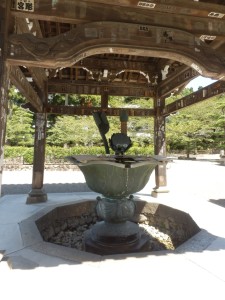 The temizuya (hand-washing station) before you get to the temple is also striking: it’s in the shape of a lotus blossom, which I hadn’t seen at any other temple before, pilgrimage or no. Outside the Hondo, not far from the Teien garden, you will see an ancient camphor tree, thought to be over a thousand years old. It’s called Kyobokuchi, meaning “crouching tree,†and legend says that Otomo, founder of Kokawadera, crouched beneath this tree while stalking the deer.
The temizuya (hand-washing station) before you get to the temple is also striking: it’s in the shape of a lotus blossom, which I hadn’t seen at any other temple before, pilgrimage or no. Outside the Hondo, not far from the Teien garden, you will see an ancient camphor tree, thought to be over a thousand years old. It’s called Kyobokuchi, meaning “crouching tree,†and legend says that Otomo, founder of Kokawadera, crouched beneath this tree while stalking the deer.
In 770, Otomo Kujiko was in the mountains hunting for deer when he saw a bright light coming from Mt. Kazaraki. The next day, he tracked the location of the light, and found a dead deer; he repented of his hunting ways and built a hermitage on the mountain to practice austerities and atone for his killing of so many animals.
Later on, he was visited by a mysterious child who said he would carve an image of Senju Kannon, but must be left alone for seven days. Seven days later, an exquisite image of Kannon was found, but the child had disappeared—it is believed that the carver became the carved. It is this image that is said to be the one enshrined at Kokawadera. The Donan-do, dedicated to this child, is found on the temple grounds and houses the image that is open yearly on December 18th.
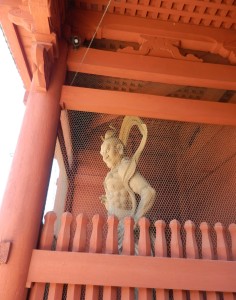 As at many temples, you will find a Mizuko Jizo, and a temple bell. The gates are carved almost entirely of precious zelkova wood, and house our familiar gate-guarding Nio kings. A garden and shrine on the hill behind the Hondo add to the beauty and gentle feel of the grounds.
As at many temples, you will find a Mizuko Jizo, and a temple bell. The gates are carved almost entirely of precious zelkova wood, and house our familiar gate-guarding Nio kings. A garden and shrine on the hill behind the Hondo add to the beauty and gentle feel of the grounds.
To get to Kokawadera, take the JR Wakayama line to Kokawadera station (not far from Wadayamamachi or Wadayama stations), then walk about 10 minutes.
Happy trails!
Lemmon
www.kokawadera.org
